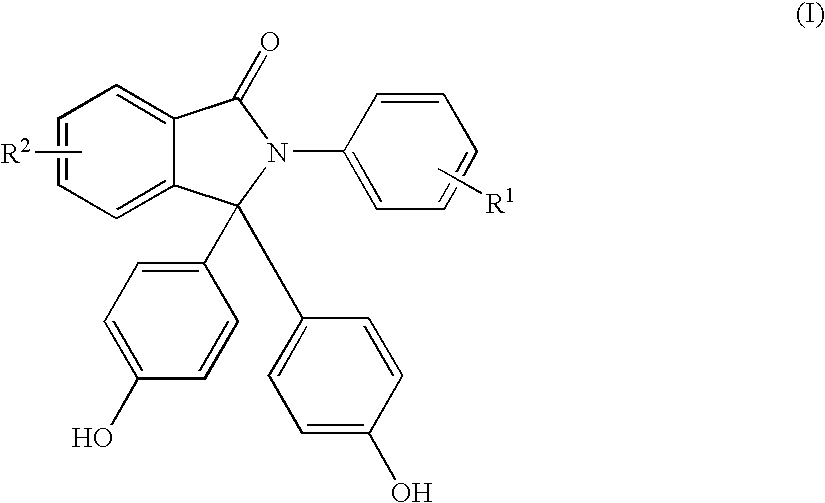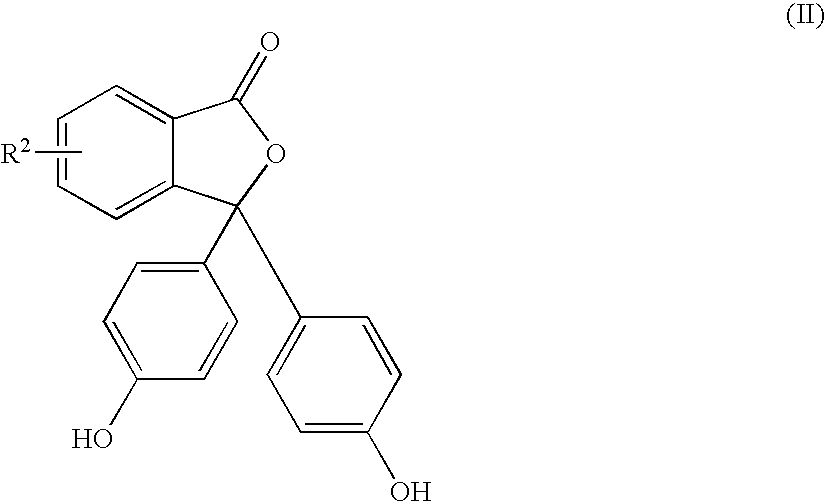Methods for producing and purifying 2-aryl-3,3-bis(4-hydroxyaryl)phthalimidine compounds, the purified monomers, and polymers derived therefrom
a technology of phthalimidine and pppbp, which is applied in the field of producing and purifying 2aryl3, 3bis (4hydroxyaryl) phthalimidine compounds, the purified compounds, and polycarbonates as well as other polymers, can solve the problems of pppbp having an unacceptable purity for use as monomers or as comonomers in subsequent polymerization reactions, foamy polymer melts and moldings, and the like. to achieve the effect of lowering
- Summary
- Abstract
- Description
- Claims
- Application Information
AI Technical Summary
Benefits of technology
Problems solved by technology
Method used
Image
Examples
examples
[0070]In the following examples, molecular weights were measured by gel permeation chromatography using polystyrene standards.
[0071]Glass transition temperatures of the polycarbonates were measured by differential scanning calorimetry by heating the sample at the rate of 10° C. to 20° C. per minute under nitrogen.
[0072]Purity of 2-phenyl-3,3-bis(4-hydroxyphenyl)phthalimidine (PPPBP) and phenolphthalein (PP) content were determined by HPLC. HPLC analysis was performed using a solution of about 50 milligrams of the sample dissolved in about 10 milliliters (mL) of methanol. The HPLC instrument was equipped with a C18 (reverse phase) column maintained at a temperature of 40° C., and an ultraviolet detector capable of detecting components at a wavelength of 230 nanometers. A solvent mixture of methanol and water of varying relative proportions was used. The flow rate was maintained at 1 milliliter per minute. Area percent assay was computed from the area value for each peak detected in t...
examples a-f
[0075]In these examples, a crude PPPBP was purified by precipitation at a range of pH values. To obtain the crude PPPBP, a mixture of PP (100 g, 0.31 moles), aniline (117 g, 1.25 moles), and concentrated aqueous hydrochloric acid (33 ml, 0.34 moles) was heated under reflux at a temperature of about 140° C. to about 145° C. for 45 hours under nitrogen. The resulting dark solution was then stirred into a mixture of water and concentrated HCl. The violet colored, crystalline crude PPPBP product was separated by filtration and washed with water.
[0076]Samples of the crude crystals (121 g) were then dissolved in 275 mL of 5% (w / v) sodium hydroxide solution. The solution was treated twice with 12 g of activated carbon, and then filtered. The filtrate was treated by drop-wise addition of concentrated HCl with stirring, until the filtrate achieved the pH indicated in Table 1. The slurry containing PPPBP solids was stirred for one hour after the desired pH was attained. Where possible, the so...
example 1
Preparation of Semicrude PPPBP by Precipitation at pH=9.5
[0078]A mixture of PP (50 g), aniline (58.5 g), and concentrated aqueous hydrochloric acid (10 M, 16.4 g) was heated under reflux at a temperature of about 140° C. to about 145° C. for 45 hours under nitrogen, with removal of water using a Dean-Stark apparatus. The resulting dark solution was then stirred into a mixture of ice and concentrated HCl. The violet colored, crystalline crude PPPBP product was separated by filtration and washed with water. At this stage, the crude PPPBP typically has a PP content of 0.5 to 0.7% by weight of the crude PPPBP. In this example, the crude PPPBP had a purity of 99.3139% as determined by HPLC, and a PP content of 0.5378 wt. % (5,378 ppm).
[0079]The crude crystals (20 g) were then dissolved in 130 mL of 4% (w / v) sodium hydroxide solution. The solution was treated twice with 2 g each of activated carbon, and then filtered. The filtrate was treated by drop-wise addition of concentrated HCl with...
PUM
| Property | Measurement | Unit |
|---|---|---|
| temperature | aaaaa | aaaaa |
| temperature | aaaaa | aaaaa |
| temperature | aaaaa | aaaaa |
Abstract
Description
Claims
Application Information
 Login to View More
Login to View More - R&D
- Intellectual Property
- Life Sciences
- Materials
- Tech Scout
- Unparalleled Data Quality
- Higher Quality Content
- 60% Fewer Hallucinations
Browse by: Latest US Patents, China's latest patents, Technical Efficacy Thesaurus, Application Domain, Technology Topic, Popular Technical Reports.
© 2025 PatSnap. All rights reserved.Legal|Privacy policy|Modern Slavery Act Transparency Statement|Sitemap|About US| Contact US: help@patsnap.com



